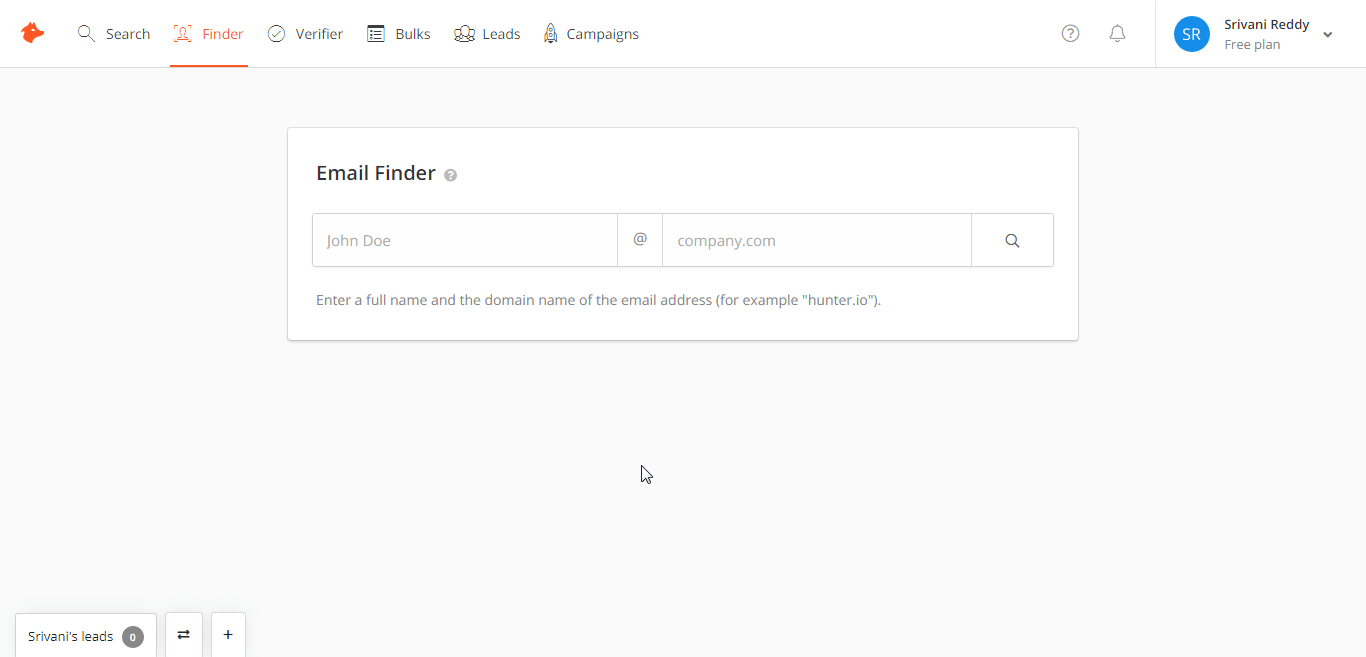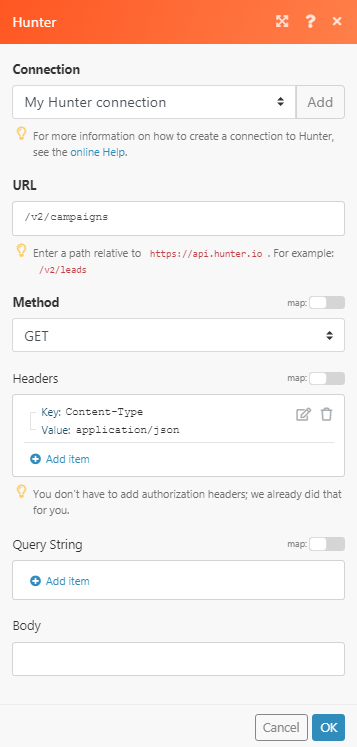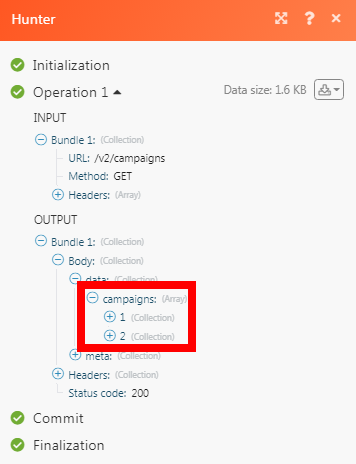| Active |
|---|
| This application does not need additional settings. So you can make connection only by using your login credentials or by following the instructions below . |
The Hunter modules allow you to watch, create, update, list, and delete the campaigns, leads, and copy, find and verify an email address in your Hunter account.
Prerequisites
-
A Hunter account
In order to use Hunter with Boost.space Integrator, it is necessary to have a Hunter account. If you do not have one, you can create a Hunter account at hunter.io/users/sign_up.
![[Note]](https://docs.boost.space/wp-content/themes/bsdocs/docs-parser/HTML/css/image/note.png) |
Note |
|---|---|
|
The module dialog fields that are displayed in bold (in the Boost.space Integrator scenario, not in this documentation article) are mandatory! |
To connect your Hunter account to Boost.space Integrator you need to obtain the API Key from your Hunter account and insert it in the Create a connection dialog in the Boost.space Integrator module.
1. Log in to your Hunter account and open your Dashboard.
2. Click Your Profile Icon > API.

3. Copy the API Key to your clipboard.

4. Go to Boost.space Integrator and open the Hunter module’s Create a connection dialog.

5. In the Connection name field, enter a name for the connection.
6. In the API Key field, enter the API key copied in step 3 and click Continue.
The connection has been established.
Lists leads.
|
Connection |
|
|
Lead List ID |
Select the Lead List ID whose leads you want to list. |
|
|
Enter the lead’s email address you want to search. |
|
First Name |
Enter the lead’s first name to search for the leads with the specified name. |
|
Last Name |
Enter the lead’s last name to search for the leads with the specified name. |
|
Position |
Enter the job title to search for the leads with the specified position. |
|
Company |
Enter the company name to search for the leads with the specified name. |
|
Industry |
Enter the industry name to search for the leads with the specified industry. |
|
Website |
Enter the lead’s or lead’s company website URL address |
|
Country Code |
Enter the lead’s country code to search for the leads with the specified country code. |
|
Company Size |
Enter the lead’s company size to search the leads that belong to the specified company size. |
|
Source |
Enter the lead’s source you want to search. |
|
|
Enter the lead’s or lead’s company Twitter’s account URL address to search the leads with the specified account. |
|
LinkedIn URL |
Enter the lead’s or lead’s company LinkedIn’s account URL address to search the leads with the specified account. |
|
Phone Number |
Enter the lead’s phone number to search the leads with the specified number. |
|
Sync Status |
Select the lead’s sync status:
|
|
Sending Status |
Select the lead’s sending status:
|
|
Last Activity At |
Enter the date and time of the lead’s last activity. |
|
Query |
Enter a keyword or phrase to search the leads based on the specified query. |
|
Limit |
Set the maximum number of leads Boost.space Integrator should return during one scenario execution cycle. |
Gets a lead.
|
Connection |
|
|
Lead ID |
Select the Lead ID whose details you want to retrieve. |
Creates a lead.
|
Connection |
|
|
|
Enter the lead’s email address. |
|
First Name |
Enter the lead’s first name. |
|
Last Name |
Enter the lead’s last name. |
|
Position |
Enter the lead’s job title or position |
|
Company |
Enter the lead’s company name. |
|
Company Industry |
Enter the lead’s company industry is into. For example, |
|
Company Size |
Enter the lead’s company employee size. For example, |
|
Confidence Score |
Enter the confidence score percentage that the lead might convert into a customer. For example, |
|
Website |
Enter the lead’s company website URL address. |
|
Country Code |
Enter the lead company’s country code. |
|
LinkedIn URL |
Enter the lead company’s country code. |
|
Phone Number |
Enter the lead’s company’s contact phone number. |
|
|
Enter the lead’s company’s Twitter URL account. |
|
Notes |
Enter any additional information about the lead or lead’s company which you would like to mention. |
|
Source |
Enter the source details from where you received the lead’s information. For example, |
|
Leads List ID |
Select the Leads List ID to which you want to add the contact. |
|
Custom Attributes |
Add the custom fields and their values. For example, |
Updates a lead.
|
Connection |
|
|
Lead ID |
Select the Lead ID whose details you want to update. |
|
|
Enter the lead’s email address. |
|
First Name |
Enter the lead’s first name. |
|
Last Name |
Enter the lead’s last name. |
|
Position |
Enter the lead’s job title or position |
|
Company |
Enter the lead’s company name. |
|
Company Industry |
Enter the lead’s company industry is into. For example, |
|
Company Size |
Enter the lead’s company employee size. For example, |
|
Confidence Score |
Enter the confidence score percentage that the lead might convert into a customer. For example, |
|
Website |
Enter the lead’s company website URL address. |
|
Country Code |
Enter the lead company’s country code. |
|
LinkedIn URL |
Enter the lead company’s country code. |
|
Phone Number |
Enter the lead’s company’s contact phone number. |
|
|
Enter the lead’s company’s Twitter URL account. |
|
Notes |
Enter any additional information about the lead or lead’s company which you would like to mention. |
|
Source |
Enter the source details from where you received the lead’s information. For example, |
|
Leads List ID |
Select the Leads List ID to which you want to add the contact. |
|
Custom Attributes |
Add the custom fields and their values. For example, |
Deletes a lead.
|
Connection |
|
|
Lead ID |
Select the Lead ID you want to delete. |
Creates one or several recipients.
|
Connection |
|
|
Campaign ID |
Select the Campaign ID to which you want to add the recipients. |
|
Emails |
Add the email address of the recipients to whom you want to send the campaign. |
Checks how many email addresses are there for one domain or one company.
|
Search By |
Select the option to search the emails. |
|
Domain |
Enter the domain address to search the emails only with the specified |
|
Company |
Enter the company name to search the email address of the specified company. |
|
Type |
Select the email type:
|
Generates or retrieves the most likely email address from a domain name, first name, and last name.
|
Connection |
|
|
Search By |
Select the option to search the email:
|
|
Domain |
Enter the domain details of the email address whose details you want to retrieve. |
|
Company ID |
Enter the Company ID of the email address whose details you want to retrieve. |
|
First Name |
Enter the contact’s first name whose email address you are searching for. |
|
Last Name |
Enter the contact’s last name whose email address you are searching for. |
|
Full Name |
Enter the contact’s full name whose email address you are searching for. |
|
Max Duration |
Enter the maximum duration (in seconds) of the request. You must provide a range between 3 and 20. |
Verifies the deliverability of an email address.
|
Connection |
|
|
|
Enter the email address which you want to verify. |
Triggers when a new campaign is available to your account.
|
Connection |
|
|
Limit |
Set the maximum number of campaigns Boost.space Integrator should return during one scenario execution cycle. |
Performs an arbitrary authorized API call.
|
Connection |
||||
|
URL |
Enter a path relative to
|
|||
|
Method |
Select the HTTP method you want to use: GET to retrieve information for an entry. POST to create a new entry. PUT to update/replace an existing entry. PATCH to make a partial entry update. DELETE to delete an entry. |
|||
|
Headers |
Enter the desired request headers. You don’t have to add authorization headers; we already did that for you. |
|||
|
Query String |
Enter the request query string. |
|||
|
Body |
Enter the body content for your API call. |



